Menu

Did you know that in a typical Vegetable Subscription CSA share, you get 6-10 different types of vegetables each week? This selection shows how farm subscription services are changing the way we enjoy local produce.
By using subscription models, farmers make it easy for people to get fresh, local produce. Platforms like Barn2Door help farmers sell their products online. This means they can reach customers any time of the day. Many local farms have joined in, growing their customer base. They offer a way to shop that’s both modern and keeps produce fresh. Plus, you can choose different subscription preferences to suit your needs. This makes it a win-win for both farmers and shoppers.
Local food box subscriptions are changing how we get fresh food. They deliver foods weekly or monthly. This helps local economies and makes sure we get good, fresh foods. It also makes us know the farmers better. There are four main types of subscriptions: Buy-Down, Farmers Choice plus Add-on Items, Flexible Farm Shares, and Fully Customisable Farm Shares.
In the Buy-Down Model, you pay upfront and get credit for the season. Instead of a set box each week, you can pick what you want. This gives you more choice and matches what you like to eat.
The Farmers Choice + Add-on Items model includes a set box, but you can add extra things. This lets you buy more and get what you need. It makes customers happier.
The Flexible Farm Shares model has a set price, but you can swap items if you need to. It’s great for families with different food needs. Everyone can find something they like.
Finally, the Fully Customisable Farm Shares model lets you completely pick what you want. You can change what’s in your box and how much. This means you get exactly what you want.
Platforms like Local Food Marketplace (LFM) help farmers use these models. They make it easier to sell different farm shares. Farms like Stout Oak Farm and Blue Sky Organic Farms have seen more sales and happy customers. This shows how important these farm subscriptions are for local areas.
Farm produce subscriptions are great for both consumers and local farmers. They give families fresh produce boxes. And they help keep local farming communities strong and sustainable.
Farm produce subscriptions mean you get fresh, top-quality food. You receive these items soon after they’re picked. This keeps their nutrients, taste, and quality at their best.
Customers can enjoy fresh food all year. This is because the subscription programs last from spring to fall. They offer a wide range of seasonal options.
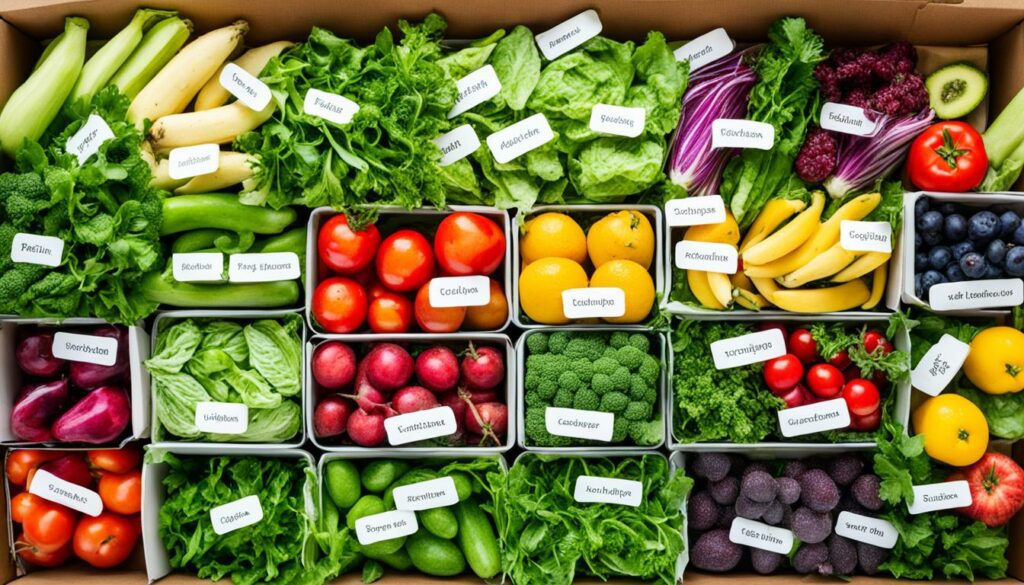
By signing up, you support local farms. This helps farmers know how much to grow, keeping them financially stable. And these programs often include more than just fruits and veg.
For example, Angelic Organics in Chicago supplies many share options. It shows how your support makes a real impact on local farmers and communities.
Fresh produce boxes are also super easy to use. You can choose how and when to get your food, depending on your life. Prices range from $25 to $40 weekly, fitting different budgets and sizes.
Joining is straightforward and flexible. With many farms in the U.S. following this model, it’s changing how we think about our food. Now, eating healthy and supporting local farmers is simpler than ever.
Agricultural subscription services now come in many types. They cater to different tastes and needs, creating a strong link between those who eat the food and those who grow it. This brings benefits to both sides, making the process more personal and enjoyable.
Vegetable boxes stand at the heart of organic farm delivery services. They deliver fresh, in-season veggies, supporting sustainable farming. Studies like one from Utah show how these services make healthy, local greens more accessible.
Fruit subscriptions offer a tasty variety with fresh, seasonal fruits. Many CSAs, including those in Utah, now add fruits to their boxes. This means subscribers can enjoy the best of each season straight from the farm.
Mixed subscriptions are great for those who love variety. They mix veggies, fruits, and sometimes special treats. This adds to the fun of each week’s delivery and helps support a wider range of farmers.
Some subscriptions go beyond the usual and include eggs, honey, or meat. This broadens the appeal, meeting more needs and making meals more exciting. It’s a great way to back sustainable farming and enjoy a wider selection of farm goods.
Subscription CSAs are set up to offer all these choices. They give farmers more control over what they grow, how much they sell it for, and when and where it’s delivered. This model supports diverse farms and local economies. For more on CSAs and their benefits, check out research and guides.
Choosing the right farm-to-table subscription starts with checking various key points. This ensures the service fits what you like and care about.
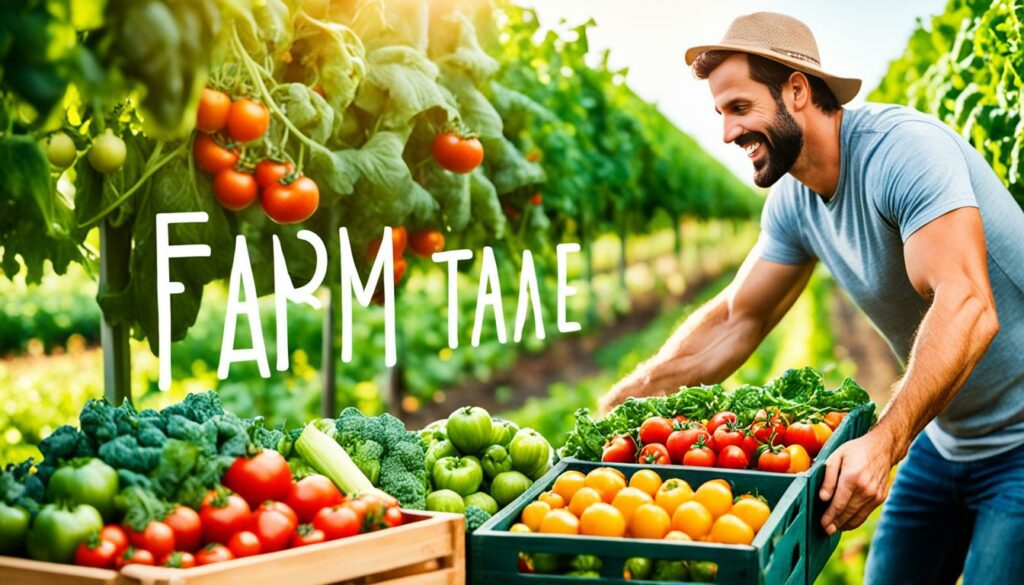
The kind of produce you can get is key. For example, Local Food Marketplace offers several Farm Share types. The Buy-Down Model works like this: you pay a big fee before the season starts. Then, you get credits to spend how you want. This system builds loyalty and gives you freedom.
It’s also crucial to look at how flexible a service is. Some let you swap items in your box at your Fancy. This is great for people with allergies or who have specific likes. Plus, a swap box adds even more flexibility. It makes these subscriptions great for anyone.
Considering add-ons is very important too. Choosing extras like Farmer’s Choice shares can make your selection wider. It can also help businesses make more money. This shows the service is keeping up with what customers are looking for.
Money matters a lot when choosing a service. The cost of a subscription can vary. For small families or two people, a light share can be around $25 a week. For bigger families, it might be closer to $40. The price also changes based on what’s in the box. Some may have special items like eggs, honey, or flowers.
This table compares different subscription models. It can help you see the pros and cons of each.
| Subscription Model | Main Features | Customer Benefits |
|---|---|---|
| Buy-Down Model | Bulk fee, spend-as-you-wish credits | Loyalty, flexibility, advance planning |
| Farmer’s Choice with Add-Ons | Pre-selected items plus add-ons | Diversified products, higher order value |
| Flexible Farm Shares | Substitutable items, swap box system | Customisation, allergy/preferences management |
| Fully Customisable CSA | Complete customisation | Personalised produce selection |
Know what’s most important to you. Whether it’s supporting local farms, choosing organic, or being able to change your box. There are many options with local food box subscriptions. Considering these points will help you make a choice that matches your values and needs.
The cost of sustainable farming subscriptions can change based on several things. It’s vital for customers to know what makes the price differ. These details give a full picture of how a subscription’s price is set.
How long and how often you subscribe is a key factor. Subscribing for a longer time can save you money. This is because you’re committing for a longer period. If you choose to receive your products more often, like every week, you might pay more.
The produce type and variety in the subscription can also change the cost. For instance, unique or organic items are usually pricier than common ones. A subscription with a variety of high-quality produce will cost more. This includes products like rare fruits or local honey. The excitement of getting top-notch items can make sustainable farming subscriptions more attractive but also increases the price.
Where the farm is and how the products reach you matters. Farms far from cities might cost more to ship from. The way you get your items, like home delivery or collecting from a spot, also plays a part. Delivery to your door is often more expensive because of the extra work.
Knowing about these factors can help customers choose wisely. Think about the subscription’s duration, the kind of products it offers, and where it’s based. This way, you can find a service that fits what you want and can afford.
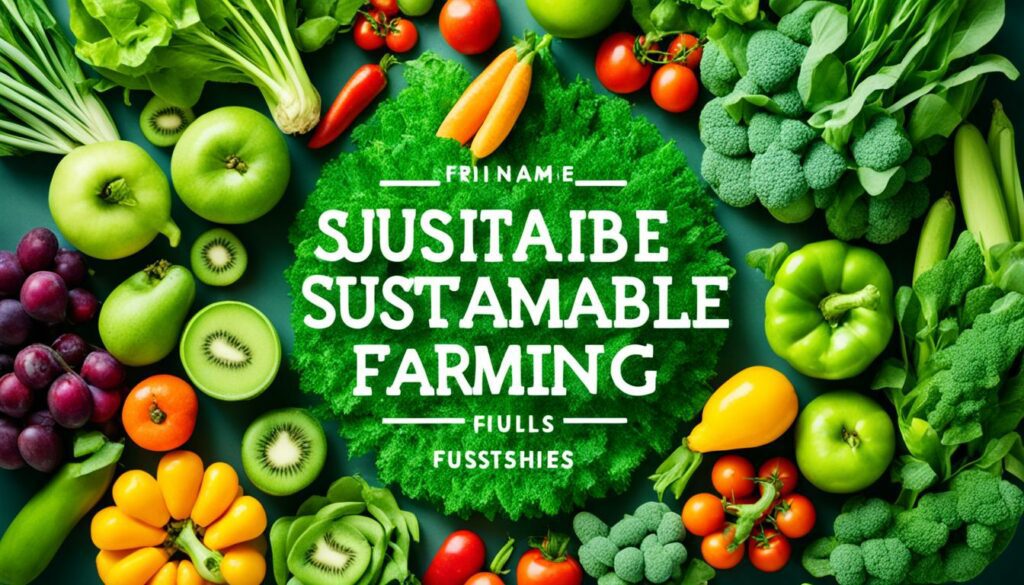
Choosing sustainable farming subscriptions is smart for those who care about the planet. It helps produce *eco-friendly farm products*, which are easy to get and good for the Earth. This way, consumers can support ethical farming without much effort.
Stack Rock Ranch is a great example. They age their beef for at least 14 days, making it tastier. Subscribing to them means getting top-quality beef at your door. It shows a real commitment to doing farming the right way.
With Stack Rock, you get the best beef conveniently and save money. It also means less waste and pollution because you buy in bulk. This shows everyone that you support farming that takes care of the planet.
Good delivery is key for these services to work. Companies like FasterCapital use smart technology to make sure your food gets to you fast. They look at past deliveries to pick the best routes, saving on fuel and time. They also use the latest traffic info and GPS to avoid delays.
Farm subscriptions are about more than just buying food. They’re about investing in farming that’s good for the environment. They match your beliefs with real actions, helping to live sustainably. Plus, they cut down on the pollution from shipping food long distances. This is important since food from farms often travels over 1,000 miles to reach stores, while local farms are usually closer.
Did you know that at farmers markets, almost half sell organic food? And food from these markets travels much shorter distances than regular stores. Many farmers also use techniques that keep the soil healthy. This shows that local farms are serious about being good to the Earth.
So, *sustainable farming subscriptions* are more than just a trend. They’re a great way to get *eco-friendly farm products* while helping the environment and local farmers.
Choosing organic farm delivery services means you can eat healthier, fresher food. You get access to top-quality, certified organic food. This food is free from harmful chemicals, helping you eat better.
Companies like Misfits Market offer organic food that’s not perfect but still good. They sell it for up to 30% less than regular stores. This makes eating organically cheaper and better for the planet. Hungry Harvest helps too. They rescue 10 pounds of food from being wasted with each box they deliver.
In the UK, Oddbox begins at only £12 for weekly boxes of sustainable food, addressing food poverty by sharing leftovers. Farm to People makes sure your money helps local farmers. By putting at least half of your food budget back into farmers’ hands, they help build a strong local economy.
FreshDirect leads online, offering more than 800 organic options. They deliver seasonally to some areas near Long Island and the Jersey Shore. From small produce boxes starting at $50 to large ones at $120, there’s something for everyone.
Farm Fresh to You has been serving Los Angeles since 2007. They offer boxes of organic food you can customise. You can get everything from eggs to meat, ensuring they meet all your nutritional needs.
Imperfect Foods fights food waste in 38 states by delivering boxes of good, but not perfect, food every two weeks. Since 2015, they’ve been a top choice for those who care about the environment.
Narrative Food in Southern California is a certified B Corp, showing they care about people and the planet. They deliver a variety of organic food, from pastured meat to freshly caught fish, catering to anyone who’s health-conscious and loves great food.
Farm-to-table subscription services have had a big impact on local areas. These two farms, Rochon Garden and Pure Conscience Farm, have seen real success. They’ve helped their local economies and communities.
Rochon Garden uses a farm-to-table subscription service to support its local economy. It grows produce without synthetic chemicals. This keeps the food fresh and healthy. The farm is close to its customers, which teaches them about sustainable farming.
This way, they also lower the carbon footprint of food transport. This makes a positive impact on the environment.
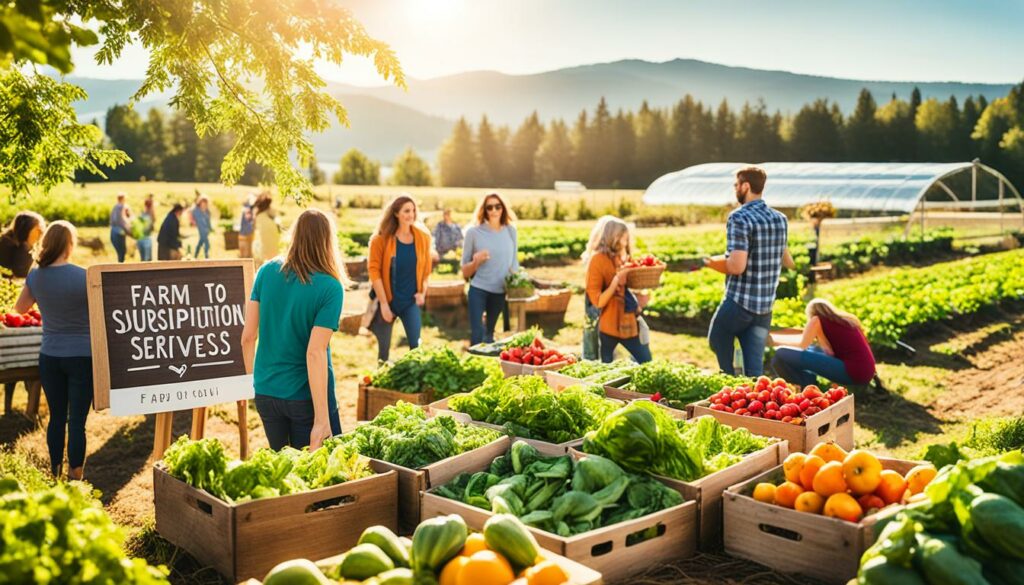
Pure Conscience Farm is known for working with local farmers to get fresh, organic produce. Its farm-to-table subscription services focus on community and being eco-friendly. They help the land stay healthy and the farm’s products to be the best they can be.
This helps the local economy grow. It also gives farmers steady incomes. This way, farmers can make good choices about their land and business.
| Case Study | Key Achievements | Community Impact |
|---|---|---|
| Rochon Garden | Reduced input costs, Ensured fresh produce | Reduced carbon emissions, Promoted sustainability |
| Pure Conscience Farm | Consistent supply of organic produce | Supported local economies, Ensured responsible consumption |
These farm stories show how farm-to-table subscription services can help the whole community. They connect people directly to local farms. This creates a reliable source of fresh and healthy food. It also encourages farmers to use eco-friendly methods.
Customising your farm produce subscription lets you choose what goes in your box. You can match it to your diet and tastes. This makes you more satisfied with what you get.
Deciding on your subscription model like Pay Upfront or Pay As You Go is important. Paying upfront gives you a better deal and less hassle. But, if you want more flexibility in your spending, you might prefer Pay As You Go.
Late signup and mixing up your orders are key to a good farm subscription. Farms like Rosebird Farms and Fiddlehead Farm let you join even if the season has started. They also let you change your box to fit your diet or food preferences. This way, you’re always happy with what you receive.
| Model | Features | Example Farm |
|---|---|---|
| Buy-Down Model | Uses credits for purchases | Stout Oak Farm |
| Add-Ons | Includes extra items | Blue Sky Organic Farms |
| Flexible Farm Shares | Item substitutions available | Rosebird Farms |
| Fully Customisable CSA | Complete control over selections | Fiddlehead Farm |
Local food marketplaces and platforms like Local Line make picking the right box easier. They offer many customisation options for your farm produce subscription. With their help, you can enjoy a more personalised selection.
Each year, around 1.03 billion tonnes of food go to waste. This is about 17% of all food made. It causes a lot of harm to our environment. It’s also a missed chance to help those in need. By managing our food sources better, we can reduce this waste. Let’s look at some ways to do this.
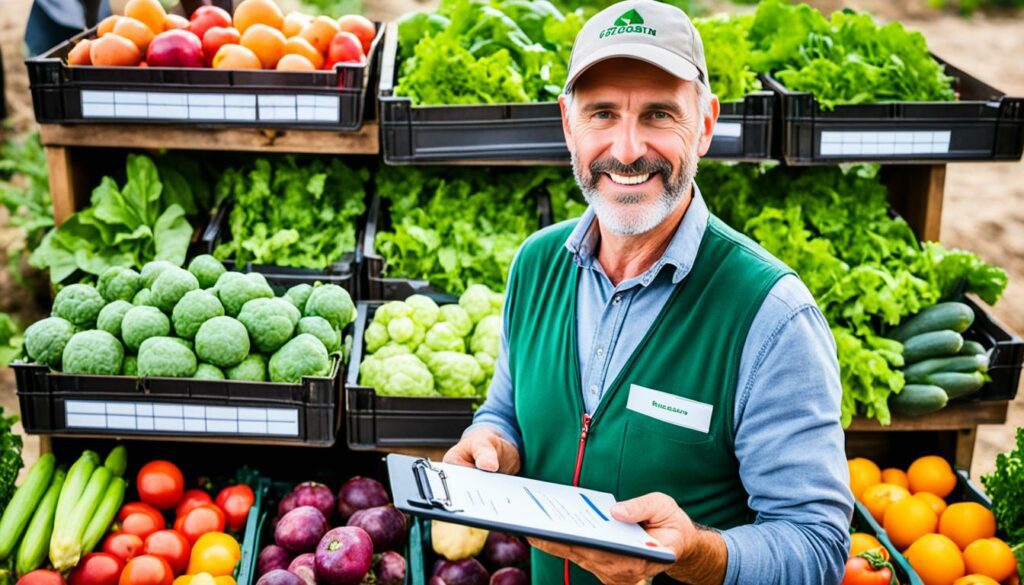
Storing your fresh produce right is key to keeping it from going bad. For instance, leafy greens do best in a chilled, humid place, like your fridge’s crisper. On the other hand, keep fruits like apples and bananas away from each other. This stops them from ripening too fast. Using these storage tips will help you cut down on food waste.
Planning your meals ahead can cut down a lot on what you throw away. Base your meals on what’s in your subscription box. Then, you’re sure to use everything. A good meal plan can also turn leftovers into tasty new dishes. This not only helps with your subscriptions but also encourages eating fresh.
If you get a lot of seasonal food, freezing, pickling, and dehydrating can make it last longer. Berries and green beans freeze well. Cucumbers and carrots are great for pickling. And dehydrated fruits and veggies make healthy snacks. These methods can all help cut down on food waste.
| Preservation Method | Best for | Example |
|---|---|---|
| Freezing | Fruits, Vegetables | Berries, Green Beans |
| Pickling | Vegetables | Cucumbers, Carrots |
| Dehydrating | Fruits, Vegetables | Apples, Tomatoes |
Following these steps lets us help reduce food waste. Learning to manage our food better not only helps local farmers. It also has a big impact on the fight against global food waste.
Modern technology has changed how farm subscriptions work. It brings new ways for both farmers and consumers to interact. This makes the farm-to-table experience more enjoyable for everyone involved.
Online ordering platforms have transformed the way we buy farm products. Barn2Door, for example, allows customers to easily find and order items. This means shopping for farm produce is quick and simple, just like buying anything else online.
Now, there are mobile-friendly apps for managing farm subscriptions. These apps allow people to easily handle their orders from anywhere. They keep consumers up-to-date on what’s new, making life more convenient in our high-speed world.
Technology has simplified how farm orders are managed and fulfilled. With special software, farms can process orders, check stock, and plan deliveries efficiently. This automation means fresher produce reaches people’s tables, with fewer mistakes along the way.
Statistics:
- Vertical farms use up to 70% less water than traditional farms.
- The entire global greenhouse market currently produces nearly US $350 billion in vegetables annually.
- A report by Grand View Research, Inc. predicts the precision agriculture market to reach $43.4 billion by 2025.
| Year | Percentage of U.S. Farmland Rented | Iowa Farmland Leased Out | Trimble Precision Ag Business Share |
|---|---|---|---|
| 2014 | 39% | N/A | N/A |
| 2017 | N/A | 53% | N/A |
| 2022 | N/A | 58% | 40% |
Companies like Trimble and John Deere are at the forefront of this change. They offer advanced tools for precision farming on a subscription basis. Their dedication to tech is shaping agriculture’s future, making the farm subscription model better than ever.
Community-supported agriculture is vital in connecting city dwellers with countryside farmers. Subscription models for farm goods help create a community vibe. They encourage regular communication and mutual help.
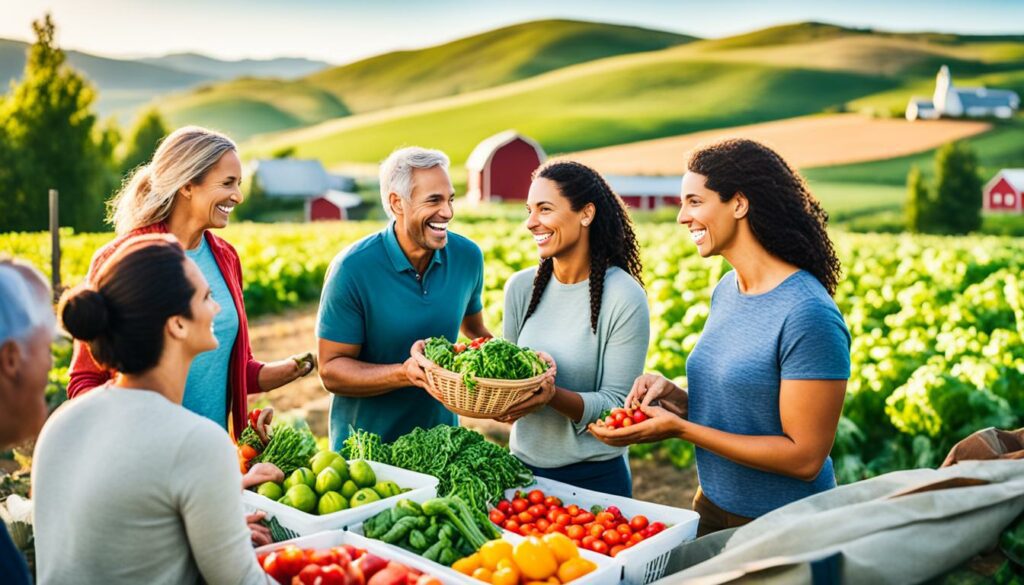
The Buy-Down Model stands out because it requires customers to pay first. They get credits to use later on farm products. This model is good for farmers’ financial stability. It also keeps customers involved. Blue Sky Organic Farms has seen more sales by adding extra features.
Rosebird Farms allows Flexible Farm Shares. This lets customers swap products, making them happier and more loyal. Fiddlehead Farm goes a step further with a fully flexible CSA. Customers can pick what they want in their share. This boosts their feeling of control over their food choices.
Platforms like Local Food Marketplace are bringing tech solutions. These help with different subscription models. They make sure both farmers and consumers get what they need.
In the US, North Carolina leads with over 100 CSAs. They are exploring new ways to build community. This includes group workdays, social gatherings, and learning events. These activities help keep members interested. They might stop people from leaving, something many CSAs face each season.
| Farm | Model | Benefit |
|---|---|---|
| Blue Sky Organic Farms | Farmers Choice + Add-on Items | Increased Sales Opportunities |
| Rosebird Farms | Flexible Farm Shares | Product Substitutions |
| Fiddlehead Farm | Fully Customizable CSA | Select Specific Items |
Community-supported agriculture thrives when everyone in the community is involved. Members’ active participation keeps local areas alive and sustainable. It also ensures people can enjoy a variety of fresh produce all year.
Customer happiness is key to the success of farm product subscriptions. Reviews from real customers tell us what’s great and what needs work.
“I have been using the subscription service from Blue Sky Organic Farms for several months now, and I am thoroughly impressed. The add-ons offered each week not only enhance variety but also make me look forward to every delivery.”
Good reviews show the power of choice in making customers happy. Stout Oak Farm asks for a big payment upfront, which makes customers more committed. But Fiddlehead Farm’s approach lets customers pick exactly what they want. This has won them praise for being flexible and focusing on customers.
Customers have also loved Rosebird Farms’ way of doing things. They can swap out items or add extra products as they like. This makes each box fit their needs perfectly, ensuring happy returns.
LFM’s software has helped many farms make their subscriptions better. It lets farms offer things like weekly extras or swapping out items. Customers love this chance to personalise their orders.
To wrap it up, happy customers show that subscription services are doing well. By making choices and personalisation easy, these services are staying popular. They’re keeping up with what their customers want over time.
Farmers who use subscription models face some tough challenges. They need to deal with the ups and downs of each season. They also have to figure out how to get their products to customers while keeping everything in balance. Yet, with planning and better communication, many farmers have found ways to overcome these challenges.
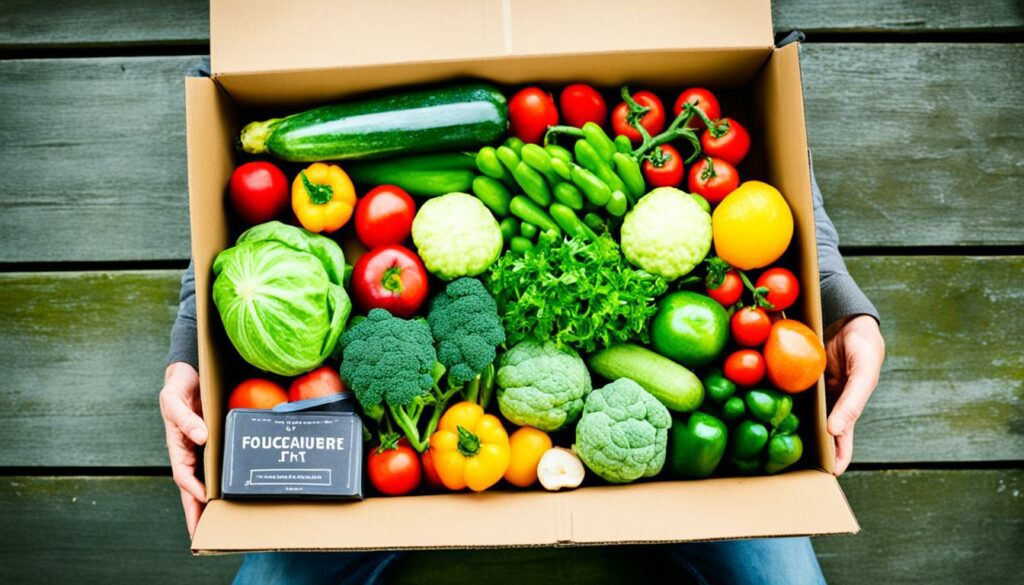
Seasonal changes are a big issue for farms using subscription models. About 55% of farmers know it’s hard to keep produce quality and variety steady. They’re against the odds of changing crop yields and weather surprises. To work around this, farms like Holistic Pantry in Eungella offer a mix of plants. These include different veggies, fruits, and flowers based on the time of year. Such variety keeps a stable flow of goods and keeps customers happy.
Handling deliveries is another huge challenge. 80% of these farms now use online shops to reach more customers. This move from local markets to the web has caused lots of unexpected issues. For example, Matthias Fehrenbacher’s farm in Crystal Creek faced higher costs going digital. They had to get smart about how they package and ship their goods. Online selling has let farms grow their customer base. It’s also helped them save on delivery costs by planning smarter.
Matching supply to demand is always a struggle. Getting prepaid orders is great for 45% of farmers. They like this because it provides early-season money. But 30% of customers find upfront payments a turn-off. So, many farms are offering a range of subscription plans. They have three-month, monthly, and yearly options. This mix meets the different needs of customers. It also helps farms better plan their supplies.
Here are some key stats on these challenges and their solutions:
| Challenge | Addressed By | Results |
|---|---|---|
| Seasonal Variability | Offer diverse, seasonal produce | Increased subscriber retention |
| Delivery Logistics | Leveraging e-commerce platforms | Broader consumer reach, optimized routes |
| Balancing Supply and Demand | Flexible subscription plans | Improved financial planning and subscriber base |
By facing up to these challenges, farms can make their subscription models better. This not only helps the farmers but also the customers, creating a win-win situation for both.
Farm produce subscriptions offer many benefits for both the farm and the customer. They help farmers by giving them money upfront. This helps farmers budget for the season and avoids financial risks. For customers, it means they get a steady supply of fresh and varied produce.
Being part of a subscription service helps customers understand where their food comes from. It links rural farms with city dwellers. This connection reminds us of the importance of sustainable food practices and the hard work of farmers.
However, there are challenges like delivering products to far-off customers on time. But, thanks to e-commerce, these obstacles are getting easier to handle. E-commerce is making it possible for farms to expand their customer base. It also allows for better management of subscriptions, personalised service, and smooth order handling.
These subscription models are reshaping the food economy for the better. More people want local, fresh produce. The use of e-commerce tools is making it easier for farms to meet this demand. The choice to support such models is a step towards a greener and more community-focused future.
Agricultural subscription services allow you to get fresh farm produce delivered to you. You subscribe to receive regular deliveries, like every week or month. You’ll get fresh vegetables, fruits, and special items directly from local farms.
Farm-to-table subscriptions ensure you receive fresh, high-quality produce. You enjoy home delivery or pickup. Plus, you support local farmers and sustainable, eco-friendly farming.
You can get various types of produce, including vegetable boxes, fruit subscriptions, and mix options. You’ll also find special items like eggs and honey. Everything comes from local farms and changes with the seasons.
Choose a farm subscription service based on what produce they offer, how they deliver, and the cost. Think about if they provide organic products, special items, and support local farming. See if they fit what you want.
The prices of farm subscriptions vary with how often you get deliveries and what produce you choose. Your location and the farm’s size can also change the cost. Seasonal prices and the scale of the farm are big factors too.
Yes, sustainable farming subscriptions are good for the environment. They offer local, seasonal produce, cutting down on long transport. These subscriptions also back farming that cares about soil and plant diversity.
Organic farm delivery services are certified. This shows they sell food grown without artificial chemicals. Certifications promise you a healthy, organic diet.
Rochon Garden and Pure Conscience Farm are great examples. They’re all about local, community-supported agriculture. They offer fresh, organic food to their customers.
With farm subscriptions, you can choose how to pay and when to start. You also get to pick what and how often you want deliveries. This gives you more control over what you get.
To make the most of your subscription, learn how to store food well, plan meals, and preserve items. Freezing, pickling, and drying can help keep your food fresh. They ensure you enjoy your food fully.
Modern technology, like Barn2Door, makes it easy to order and manage subscriptions. These online tools are simple to use. They work on phones and tablets, making it convenient for you.
Farm subscriptions connect city folk with country farmers. They encourage chats on social media and share food and eco goals. These models help build a close-knit community that cares about the food they eat.
Feedback and reviews share what people think, helping others learn from real experiences. Good reviews boost a farm’s name, while tips for better service can lead to improvements.
They have to deal with changeable seasons, getting deliveries right, and matching what’s needed with how much they have. Handling these issues well means planning smart, being flexible, and talking openly with customers.